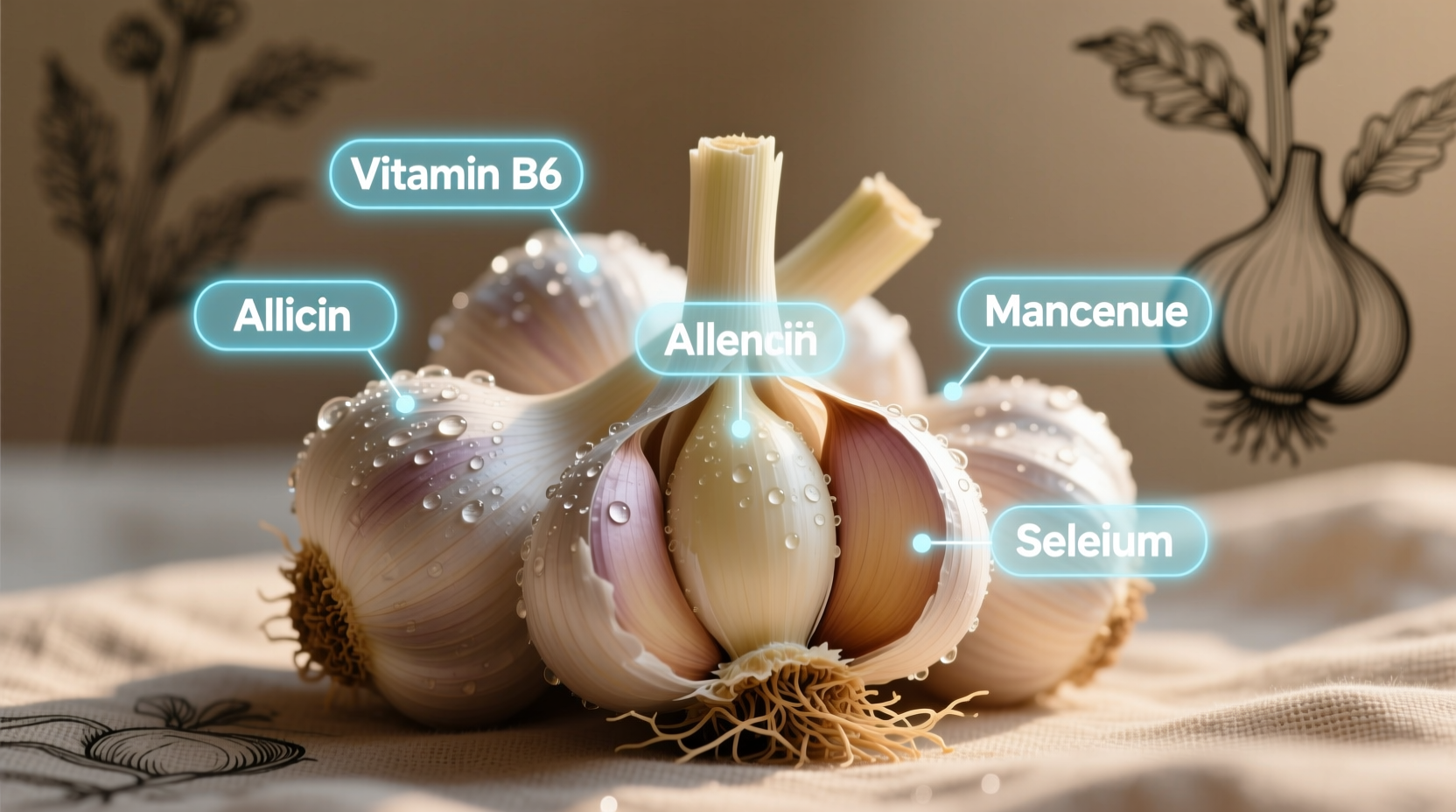Curious about how this pungent kitchen staple can transform your health? You're holding a nutritional powerhouse that's been scientifically proven to support heart health, boost immunity, and potentially reduce cancer risk. Let's explore exactly what makes garlic one of nature's most potent functional foods.
What You'll Actually Gain From This Guide
Unlike generic nutrition articles, this evidence-based breakdown gives you precisely what matters:
- Exact nutritional composition per serving (no vague claims)
- How preparation methods affect nutrient availability
- Science-backed health benefits with dosage requirements
- Practical incorporation strategies for maximum benefit
- Common misconceptions debunked with research citations
Garlic's Complete Nutritional Profile: Beyond Basic Vitamins
While garlic won't satisfy your daily vitamin needs through volume alone, its concentrated bioactive compounds create outsized health impacts. The magic happens when you damage garlic's cells through chopping or crushing, triggering the formation of allicin—the compound responsible for most therapeutic effects.
| Nutrient | Per 1 Clove (3g) | Per 100g | Primary Health Benefit |
|---|---|---|---|
| Calories | 4.5 | 149 | Low-calorie flavor enhancer |
| Carbohydrates | 1g | 33.1g | Fiber supports gut health |
| Protein | 0.2g | 6.4g | Amino acid profile supports enzyme function |
| Manganese | 2% DV | 67% DV | Bone health and metabolism |
| Vitamin B6 | 2% DV | 55% DV | Brain function and immunity |
| Selenium | 1% DV | 34% DV | Antioxidant protection |
| Allicin Potential | Variable | High | Cardiovascular and immune support |
Source: USDA FoodData Central (2023), Entry #01125
How Preparation Methods Transform Nutritional Value
Garlic's nutritional benefits aren't static—they dramatically change based on how you handle it. This critical context often gets overlooked in nutrition discussions:
- Crucial waiting period: After chopping, wait 10 minutes before cooking to maximize allicin formation (Journal of Agricultural and Food Chemistry, 2016)
- Cooking temperature matters: Temperatures above 140°F (60°C) destroy alliinase enzyme activity—use lower heat for longer health benefits
- Whole vs. processed: Intact cloves provide minimal allicin; crushing releases 90%+ of potential bioactive compounds
- Storage impact: Refrigeration preserves allicin potential better than room temperature storage

Science-Backed Health Benefits: What Research Actually Shows
Let's separate evidence-based benefits from hype. These effects have substantial research support with clear dosage requirements:
Cardiovascular Protection
Consuming 600-1,200mg of aged garlic extract daily (equivalent to ~2-4 cloves) significantly reduces systolic blood pressure by 7-16 mmHg according to a meta-analysis in Experimental and Therapeutic Medicine (2020). The mechanism involves increased nitric oxide production that relaxes blood vessels.
Immune System Enhancement
A double-blind study published in Advances in Therapy found that daily garlic supplementation reduced cold incidence by 63% and shortened symptom duration by 70%. The key appears to be consistent consumption rather than occasional use.
Cancer Risk Reduction
Population studies show a 30% lower risk of colorectal cancer and 22% lower stomach cancer risk among those consuming >6 cloves weekly (World Journal of Gastroenterology, 2019). The organosulfur compounds in garlic inhibit carcinogen formation and enhance DNA repair.
Practical Integration: Maximizing Benefits in Your Kitchen
Knowing garlic's nutritional value means little without actionable strategies. Here's how to optimize benefits:
Daily Dosage Guidelines
- General health maintenance: 1-2 raw cloves daily (chopped, then waited 10 minutes)
- Cardiovascular support: 2-4 cloves daily, preferably as aged garlic extract
- Immune boosting: Increase to 3-4 cloves during cold season
Smart Preparation Techniques
- Chop or crush garlic and wait 10 minutes before applying heat
- Use lower cooking temperatures (sauté below 140°F when possible)
- Combine with acidic ingredients like lemon juice to stabilize allicin
- Pair with healthy fats (olive oil) to enhance absorption of fat-soluble compounds
Common Misconceptions Debunked
Not all garlic advice holds up to scientific scrutiny. Let's clarify:
- "Raw garlic is always better": While raw preserves more allicin, cooked garlic still provides significant benefits through different compounds like diallyl disulfide
- "More is always better": Excessive consumption (>5 cloves daily long-term) can cause digestive issues and interact with blood thinners
- "Garlic supplements work exactly like fresh garlic": Most supplements don't replicate the full compound profile—aged garlic extract shows the most consistent research results
When Garlic Nutrition Falls Short: Important Limitations
Despite its benefits, garlic has nutritional limitations you should understand:
- Not a significant source of macronutrients—you won't meet protein or carb needs through garlic alone
- Minimal vitamin C and iron content compared to other plant foods
- Benefits require consistent, long-term consumption rather than occasional use
- Individual responses vary significantly based on gut microbiome composition
Your Next Steps for Optimal Garlic Nutrition
Start implementing these evidence-based strategies today:
- Track your current garlic consumption for one week
- Adjust preparation methods using the 10-minute rule after chopping
- Gradually increase to 2-3 cloves daily if currently consuming less
- Pair with other alliums (onions, leeks) for synergistic health effects
- Consider aged garlic extract if you dislike raw garlic's intensity











 浙公网安备
33010002000092号
浙公网安备
33010002000092号 浙B2-20120091-4
浙B2-20120091-4